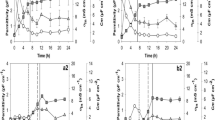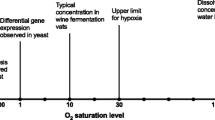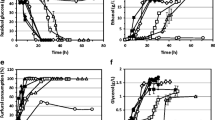Abstract
Acidification power, defined as the sum of the spontaneous pH change determined after suspending yeast cells in water and the substrate-induced pH change after addition of glucose to the resulting suspension, reflects the level of cellular energy sources. Its use as an indicator of metabolic state of the cells was tested during a 120-h aerobic starvation. Its changes coincided with changes in cell viability, initial rate of endogenous oxygen consumption rate, cell ATP, extra- and intracellular buffering capacity, and the ability of cell-free extract to produce acidity by glucose fermentation. It was used as a sensitive marker of metabolic changes occurring during starvation, on treatment with glycolytic and respiratory inhibitors, and at elevated temperature.
Similar content being viewed by others
References
Arnold W.N.: Volume and enzyme content of the periplasmic space in yeast.Physiol. Chem. Phys. 5, 117 (1973).
Betz H.: Inhibition of protein synthesis stimulates intracellular protein degradation in growing yeast cells.Biochem. Biophys. Res. Commun. 72, 121 (1976).
Conway E.J.:Microdiffusion Analysis and Volumetric Errors. Crosby Lockwood, London 1957.
Halvorson H.: Intracellular protein and nucleic acid turnover in resting yeast cells.Biochim. Biophys. Acta 27, 255 (1958a).
Halvorson H.: Studies on protein and nucleic acid turnover in growing cultures of yeast.Biochim. Biophys. Acta 27, 267 (1958b).
Hemmings B. A.: Evidence for the degradation of nicotinamide adenine dinucleotide phosphate-dependent glutamate dehydrogenase ofCandida utilis during rapid enzyme inactivation.J. Bacteriol. 133, 867 (1978).
Kalbhen D.A., Koch H.J.: Metodische Untersuchungen zur quantitativen Mikrobestimmung von ATP in biologischem Material mit dem Firefly-Enzymsystem.Z. Klin. Chem. Klin. Biochem,5, 299 (1967).
Kotyk A., Sigler K.: Transmembrane movements of protons in simple eukaryotic cells.Studia Biophys. 84, 55 (1981).
Low’ry O.H., Rosenbrough N.J., Farr A.L., Randall R.J.: Protein measurement with the Folin phenol reagent.J. Biol. Cheem. 193, 265 (1951).
Mazón M.J.: Effect of glucose starvation on the nicotinamide adenine dinucleotide phosphate-dependent glutamate dehydrogenase of yeast.J. Bacteriol. 133, 780 (1978).
McElroy W.D.: Crystalline firefly lucipherase, p. 445 inMethods in Enzymology, Vol. VI (S.P. Colowick, N.O. Kaplan, Eds). Academic Press, New York — London 1963.
Páca J.: Reserve carbohydrate metabolism and cell survival in aerobically starving baker’s yeast.J. Inst. Brew. 87, 147 (1981).
Riemersma J.C., Alsbach E.J.J.: Proton translocation during anaerobic energy production inSaccharomyces cerevisiae.Biochim. Biophys. Acta 339, 274 (1974).
Rodriguez-Navarro A., Sancho E.D.: Cation exchanges of yeast in the absence of magnesium.Biochim. Biophys.Acta 552, 322 (1979).
Sigler K., Opekarová M., Knotková A.: Spontaneous and substrate-induced proton extrusion in yeast.15th Annivers.Congr.Czech.Microbiol.Soc., Abstr. 0–11, Gottwaldov 1980.
Sigler K., Knotková A., Kotyk A.: Factors governing substrate-induced generation and extrusion of protons in the yeastSaccharomyces cerevisiae.Biochim. Biophys. Acta 643, 572 (1981a).
Sigler K., Kotyk A., Knotková A., Opekarová M.: Processes involved in the creation of buffering capacity and in substrate-induced proton extrusion in the yeastSaccharomyces cerevisiae.Biochim. Biophys. Acta 643, 583 (1981b).
Sigler K., Opekarová M., Kotyk A.: Determination of metabolic activity of glucose-metabolizing yeast cells.Czech. Pat. 215 861 (1982).
Wolf D.H.: Control of metabolism in yeast and other lower eukaryotes through the action of proteinases, p. 267 inAdvances in Microbial Physiology, Vol.21 (A.H. Rose, J.G. Morris, Eds). Academic Press, London 1980.
Wolf D.H., Holzer H.: Proteolysis in yeast, p. 431 inMicroorganisms and Nitrogen Sources (J.W. Payne, Ed.). John Wiley & Sons, New York 1980.
Author information
Authors and Affiliations
Rights and permissions
About this article
Cite this article
Opekarová, M., Sigler, K. Acidification power: Indicator of metabolic activity and autolytic changes inSaccharomyces cerevisiae . Folia Microbiol 27, 395–403 (1982). https://doi.org/10.1007/BF02876450
Received:
Issue Date:
DOI: https://doi.org/10.1007/BF02876450




